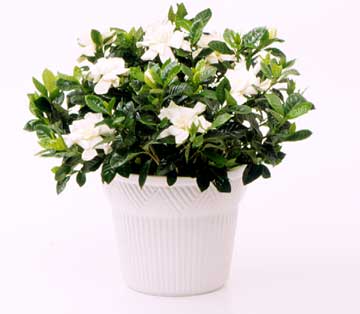





 The gardenia is just one of
several plants that needs
acid fertilizer.
The gardenia is just one of
several plants that needs
acid fertilizer.
All plants need certain chemicals to grow well. Outdoors, they send out miles of roots when they can't find what they need nearby. Indoors, though, they don't have that option. So provide your houseplants with regular feedings of organic (natural) or inorganic (synthetic) fertilizers.
The three major nutrients that plants receive from fertilizers are nitrogen, phosphorus, and potassium (usually abbreviated as N, P, and K on packages). Nitrogen is important for good foliage, phosphorus helps roots grow, and potassium is vital for good blooming.
The percentages of the major nutrients contained in any given fertilizer are listed on the label. A 10-10-10 fertilizer is made up of 10 percent nitrogen, 10 percent phosphorus, and 10 percent potassium; the other 70 percent is either organic or inert material. The percentages of the individual chemicals vary considerably by the product, but they always are listed in the same order. The higher the number, the more chemical present.
Common organic fertilizers are blood meal, bonemeal, cow manure, fish emulsion, and kelp products. Chemical fertilizers are sold under a variety of product names. The chemical analysis varies by brand. Read labels carefully.
Some of these fertilizers are formulated with specific plants in mind. A few plants -- such as azalea (rhododendron), camellia, and gardenia -- need acid fertilizers, which keep the pH of the soil low. Other plants need varying amounts of specific chemicals, and the formulas for these plants reflects this.
You can apply fertilizers in a number of ways:
continue reading belowOrganic fertilizers work slowly. It takes time for them to break down in the soil and release nutrients. Some time-release chemical formulas also break down slowly, releasing nutrients over a long period of time. Most chemical fertilizers, however, work rapidly, giving plants a quick boost.
Before applying any fertilizer, thoroughly moisten the soil. Never use more than the recommended dose; too much fertilizer can burn roots and kill plants. In fact, it's generally better to use less than the recommended amount and apply the fertilizer more frequently. This is especially true for chemical fertilizers, which tend to be more caustic than organic ones.
The goal of fertilizing is to encourage regular -- not rampant -- growth during a plant's main growing season. Do not feed plants when they're dormant, usually in fall and winter, although some plants go dormant in spring and summer.
Click here for more houseplant care tips.
Copyright © www.100flowers.win Botanic Garden All Rights Reserved